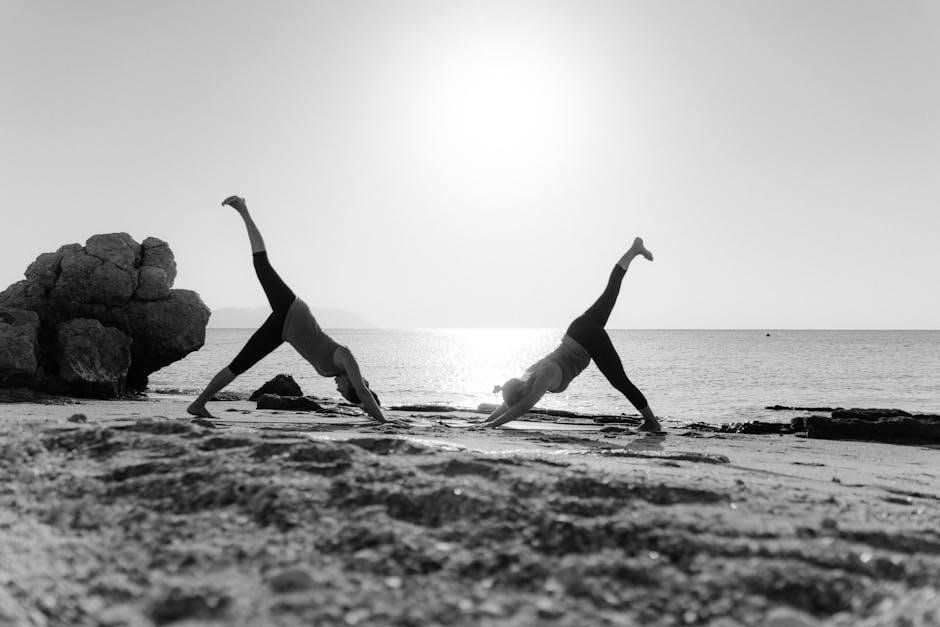
Stretching Exercises PDF Free Download: A Comprehensive Guide
Embark on a journey to enhanced flexibility and well-being with our comprehensive guide to stretching exercises. We offer invaluable resources, including a free downloadable PDF, designed to help you improve range of motion, reduce injury risks, and achieve optimal physical health through consistent stretching practices.
Stretching exercises form a cornerstone of physical fitness, enhancing overall well-being through improved flexibility and neuromuscular coordination. These exercises involve lengthening muscles to increase their elasticity, promoting a greater range of motion in joints. Stretching is a safe and useful activity for healthy adults.
The practice of stretching is not merely about achieving extreme flexibility; it’s about maintaining the body’s natural ability to move freely and efficiently. Regular stretching can help prevent injuries by reducing muscle tightness and improving balance. It’s a vital component of both warming up and cooling down routines.
Whether you’re an athlete, a fitness enthusiast, or simply someone seeking to improve their daily comfort, incorporating stretching into your routine can yield significant benefits. Stretching exercises should be performed in a slow, controlled manner and held in a sustained stretch for 20 to 30 seconds. This guide will delve into the various types of stretching, proper techniques, and provide resources for free stretching exercise PDFs.
Benefits of Regular Stretching
Regular stretching offers a multitude of benefits that extend beyond just physical flexibility. Consistent stretching enhances overall muscle length, contributing to a reduced risk of injuries such as muscle strains, pulls, or tears. By improving flexibility, stretching allows for a greater range of motion in joints, making everyday activities easier and more comfortable.

Stretching also plays a crucial role in improving neuromuscular coordination, which enhances balance and postural control. This is particularly beneficial for older adults, as it can help reduce the risk of falls. Furthermore, stretching can help control postural fatigue by addressing muscular imbalances and promoting proper alignment.
Beyond the physical advantages, regular stretching can also have a positive impact on mental well-being. It can help reduce stress and tension, promoting relaxation and a sense of calm. By incorporating stretching into your daily routine, you can experience a holistic improvement in your overall health and quality of life. Stretching increases range of motion and reduces sprain-strain injury risks.
Types of Stretching Exercises
Stretching exercises are diverse, catering to various needs and fitness levels. Understanding the different types is crucial for designing an effective and safe stretching routine. Two primary categories are dynamic and static stretching, each with unique characteristics and benefits. Dynamic stretching involves active movements that take muscles through a full range of motion.
These movements prepare the body for activity by increasing blood flow and muscle temperature. Examples include arm circles, hip circles, and leg swings. Static stretching, on the other hand, involves holding a stretch in a fixed position for a sustained period, typically 20 to 30 seconds. This type of stretching is effective for improving flexibility and range of motion.
Other types of stretching include ballistic stretching, which uses bouncing movements to force a stretch beyond its normal range, but it carries a higher risk of injury. Proprioceptive Neuromuscular Facilitation (PNF) stretching involves contracting and relaxing muscles to achieve a greater stretch. Choosing the right type depends on your goals and physical condition.
Dynamic Stretching
Dynamic stretching is an active form of stretching that utilizes movement to improve flexibility and prepare muscles for physical activity. Unlike static stretching, which involves holding a position, dynamic stretches involve controlled, flowing motions that take your muscles through their full range. This type of stretching is particularly effective as a warm-up before exercise, as it increases blood flow, elevates muscle temperature, and improves neuromuscular coordination.

Examples of dynamic stretches include arm circles, leg swings, torso twists, and walking lunges with a twist. Each movement should be performed with control and focus, avoiding jerky or bouncing motions. The goal is to gradually increase the range of motion with each repetition, preparing the muscles and joints for the demands of the upcoming activity. Dynamic stretching helps to reduce the risk of injury by enhancing muscle elasticity and improving joint mobility.
It is an integral part of any comprehensive fitness routine, promoting both flexibility and readiness for physical exertion. By incorporating dynamic stretches into your warm-up, you can optimize performance and minimize the likelihood of strains or sprains.
Static Stretching

Static stretching involves holding a stretch in a stationary position for a period of time, typically 20-30 seconds. This type of stretching is commonly used to improve flexibility and increase range of motion. It is most effective when performed after exercise or as part of a cool-down routine, when muscles are already warm and pliable. Static stretches help to lengthen muscles and reduce tension, promoting relaxation and recovery.
Common examples of static stretches include hamstring stretches, quad stretches, calf stretches, and shoulder stretches. To perform a static stretch, gently move into the desired position until you feel a mild tension in the targeted muscle. Hold this position without bouncing or forcing the stretch. Focus on relaxing and breathing deeply to enhance the stretch and promote muscle relaxation. Static stretching should be performed in a slow, controlled manner to avoid injury.
Regular static stretching can improve overall flexibility, reduce muscle soreness, and enhance athletic performance. It is an essential component of a well-rounded fitness program, contributing to both physical and mental well-being. Remember to listen to your body and avoid pushing yourself beyond a comfortable range of motion.
Important Considerations for Stretching
Before embarking on a stretching routine, it’s crucial to understand several key considerations to maximize benefits and minimize the risk of injury. Stretching is a safe and useful activity, but improper execution can lead to strains or other complications. Always prioritize proper technique and form to ensure you’re targeting the correct muscles and avoiding undue stress on joints. Maintain a slow, controlled manner throughout each stretch, avoiding bouncy or jerky movements.
Pay close attention to your body’s signals. You should feel a gentle tension in the muscle being stretched, but never pain. If you experience sharp or intense pain, immediately stop the stretch and consult with a healthcare professional. Duration and frequency are also important factors. Holding each stretch for 20-30 seconds is generally recommended to allow the muscle to lengthen effectively. The frequency of stretching depends on your individual goals and needs, but aim for regular sessions, ideally several times per week, to maintain and improve flexibility.
Remember to warm up your muscles before stretching, especially before engaging in dynamic stretches. A light cardio activity, such as jogging or jumping jacks, can increase blood flow and prepare your muscles for stretching. Listen to your body and adapt your stretching routine as needed to accommodate any limitations or injuries.
Proper Technique and Form
Mastering proper technique and form is paramount to safely and effectively execute stretching exercises. Incorrect form can not only diminish the benefits of stretching but also increase the risk of injury. Each stretch should be performed with mindful attention to alignment and controlled movements. Begin by assuming the correct starting position for the specific stretch, ensuring your body is stable and balanced. As you move into the stretch, focus on isolating the targeted muscle group and maintaining a straight line from head to toe, unless otherwise specified.
Avoid rounding your back, hyperextending your joints, or twisting your body in unnatural ways. Engage your core muscles to provide stability and support throughout the stretch. Breathe deeply and evenly, allowing your body to relax into the stretch. Never force a stretch beyond your current range of motion. Instead, gradually increase the intensity as your flexibility improves. Visualize the muscle fibers lengthening and relaxing as you hold the stretch.

If you’re unsure about the proper form for a particular stretch, seek guidance from a qualified fitness professional or consult reliable resources such as instructional videos or diagrams. Paying attention to detail and prioritizing proper technique will ensure that you reap the full benefits of stretching while minimizing the risk of injury. Remember, consistency and patience are key to improving flexibility and achieving long-term results.
Duration and Frequency
Optimizing the duration and frequency of stretching sessions is crucial for achieving noticeable improvements in flexibility and overall well-being. The ideal duration for holding each stretch typically ranges from 20 to 30 seconds. This allows sufficient time for the targeted muscles to relax and lengthen, promoting increased range of motion. Avoid bouncing or jerky movements while holding a stretch, as this can trigger a stretch reflex and potentially lead to muscle injury. Instead, aim for a sustained, controlled stretch that gradually increases in intensity as your muscles adapt.
As for frequency, incorporating stretching into your routine on a regular basis is key to reaping its benefits. Ideally, you should aim to stretch at least 2-3 times per week, although daily stretching can be even more beneficial, especially for individuals with limited flexibility or specific muscle imbalances. Consider incorporating stretching into your warm-up routine before exercise to prepare your muscles for activity, or as part of your cool-down to promote relaxation and recovery.
Listen to your body and adjust the duration and frequency of your stretching sessions based on your individual needs and preferences. If you experience any pain or discomfort, stop the stretch immediately and consult with a healthcare professional. Consistency is key when it comes to stretching, so find a routine that you can realistically stick to and gradually increase the intensity and duration as your flexibility improves over time.
Sample Stretching Routine
Here’s a sample stretching routine you can incorporate into your daily or weekly schedule. Remember to consult your doctor before starting any new exercise program. Begin with a gentle warm-up, such as light cardio or arm circles, for about 5 minutes. This prepares your muscles for stretching and reduces the risk of injury. Hold each stretch for 20-30 seconds, focusing on controlled movements and deep breathing.
Start with a neck stretch, gently tilting your head to each side and forward, holding each position. Then, move to shoulder stretches, such as cross-body arm stretches and overhead tricep stretches. Follow with chest stretches, like doorway stretches, to improve posture. For your back, try seated twists and cat-cow stretches.
Next, focus on your lower body. Perform hamstring stretches, such as seated toe touches or lying hamstring stretches with a towel. Stretch your quadriceps with standing quad stretches, holding your foot towards your glutes. Don’t forget hip flexor stretches, like lunges, and calf stretches, leaning against a wall. Finish with ankle rotations and wrist stretches. Remember to breathe deeply throughout the entire routine.
Resources for Free Stretching Exercise PDFs
Finding reliable and accessible resources for stretching exercises is crucial for maintaining a consistent and effective routine. Several reputable organizations and websites offer free downloadable PDF guides that cater to various fitness levels and needs. University health services often provide comprehensive stretching guides designed for students and staff, covering a wide range of exercises targeting different muscle groups. These PDFs typically include detailed instructions and illustrations to ensure proper form and technique.
Fitness and wellness websites, such as Darebee, offer visually appealing and easy-to-follow stretching charts that can be downloaded and printed for convenient use. These resources often categorize stretches by body region or specific goals, such as improving flexibility or relieving muscle tension. Many physical therapy clinics and healthcare providers also offer free stretching exercise PDFs as part of their patient education materials. These resources may be tailored to specific conditions or injuries, providing targeted exercises to aid in recovery and rehabilitation.
Additionally, numerous fitness apps and online platforms provide access to stretching routines and guides, often including downloadable PDFs for offline use. When searching for free stretching exercise PDFs, ensure the source is credible and the information is accurate and up-to-date.





